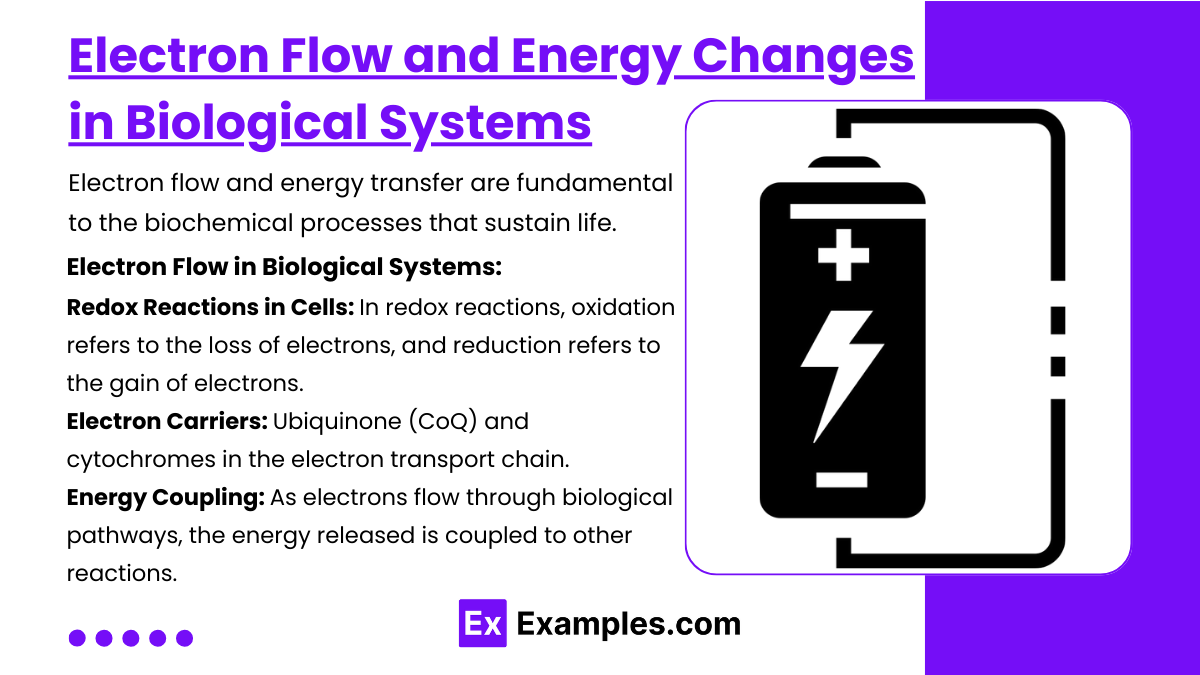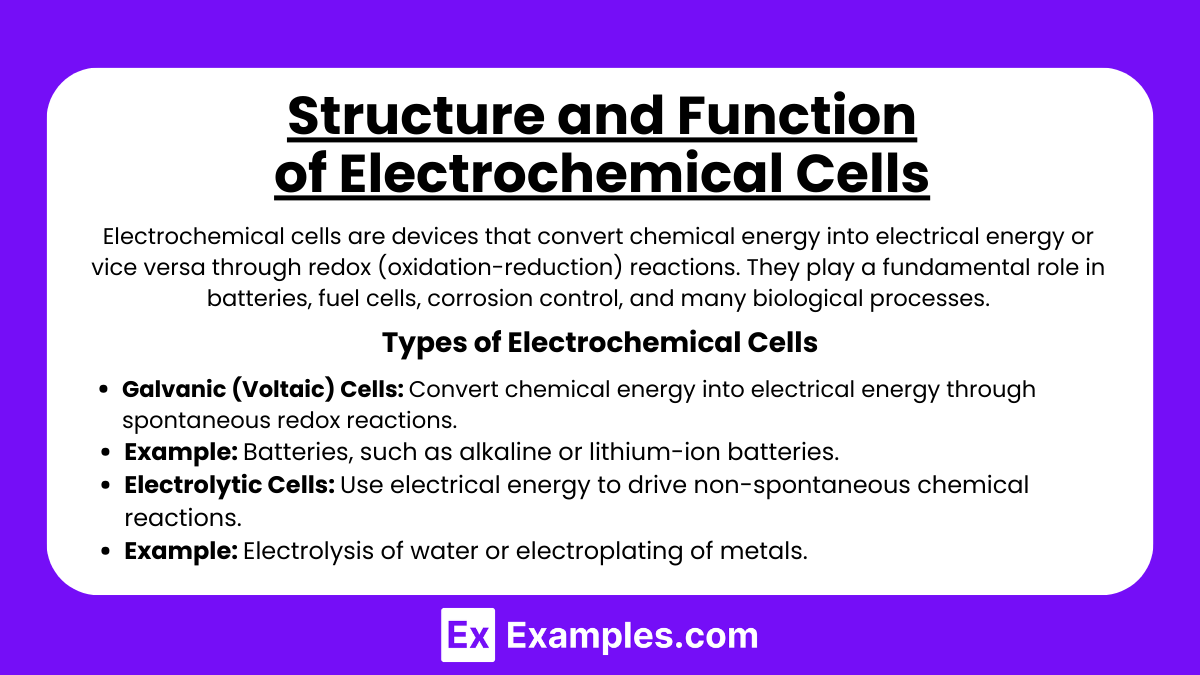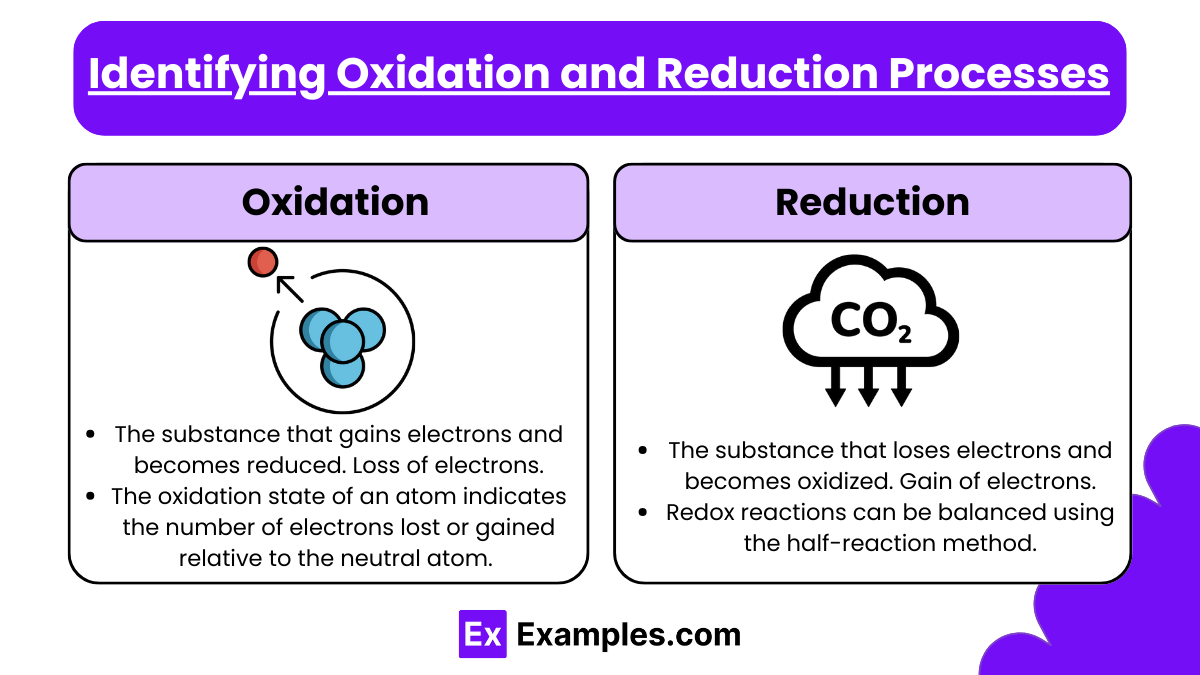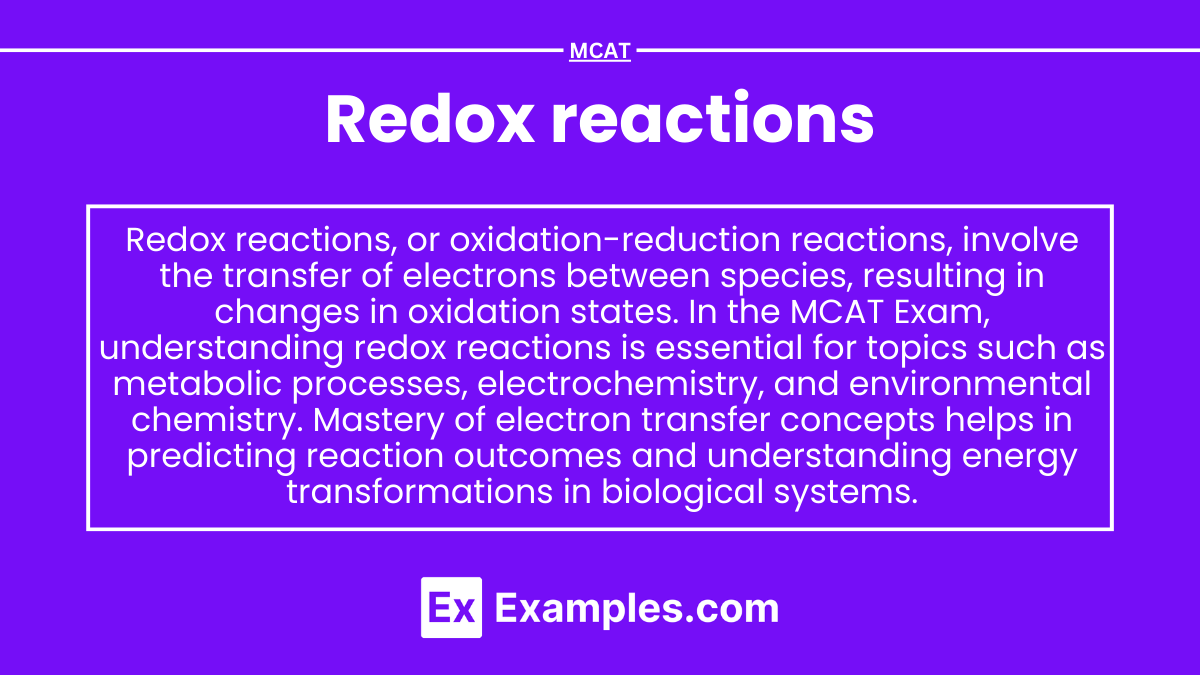Redox reactions are essential to biological and chemical processes, involving the transfer of electrons that drive energy transformations. On the MCAT, you’ll explore oxidation-reduction principles, identifying oxidizing and reducing agents, and the role of electron carriers. Mastering concepts such as redox potentials, electrochemical cells, and their biological significance is crucial, as these topics form the foundation for biochemistry, cellular respiration, and molecular biology sections of the exam.
Learning Objectives
In studying “Redox Reactions” for the MCAT, you should learn to identify oxidation and reduction processes, recognizing which species gain or lose electrons. Understand how to assign oxidation states and determine the oxidizing and reducing agents in a reaction. Analyze the flow of electrons and how it relates to energy changes in biological systems, such as cellular respiration and photosynthesis. Evaluate the structure and function of electrochemical cells, including galvanic and electrolytic cells, and their relevance to redox reactions. Additionally, apply concepts of balancing redox reactions in both acidic and basic solutions to solve MCAT-style problems involving chemical and biological redox processes.
Electron Flow and Energy Changes in Biological Systems

Electron flow and energy transfer are fundamental to the biochemical processes that sustain life. Many biological systems rely on the movement of electrons to produce energy, drive chemical reactions, and maintain cellular functions. These processes often involve the transfer of electrons through redox reactions (oxidation-reduction), where one substance donates electrons and another accepts them.
Electron Flow in Biological Systems
- Redox Reactions in Cells:
- In redox reactions, oxidation refers to the loss of electrons, and reduction refers to the gain of electrons.
- Redox reactions are essential in energy transfer, as they convert chemical energy into usable forms such as ATP (adenosine triphosphate).
- Electron Carriers:
- Biological systems use specialized molecules to transport electrons. Key electron carriers include:
- NAD⁺/NADH (Nicotinamide Adenine Dinucleotide)
- FAD/FADH₂ (Flavin Adenine Dinucleotide)
- Ubiquinone (CoQ) and cytochromes in the electron transport chain
- Biological systems use specialized molecules to transport electrons. Key electron carriers include:
- Energy Coupling:
- As electrons flow through biological pathways, the energy released is coupled to other reactions, such as the synthesis of ATP, driving key metabolic activities.
Major Biological Processes Involving Electron Flow
1. Cellular Respiration
- Electron Transport Chain (ETC):
- The ETC is a series of protein complexes located in the inner mitochondrial membrane.
- Electrons donated by NADH and FADH₂ move through the complexes, releasing energy that pumps protons across the membrane, creating a proton gradient.
- The flow of electrons culminates in the reduction of oxygen to water.
- Oxidative Phosphorylation:
- The energy from the proton gradient drives ATP synthesis via the enzyme ATP synthase, coupling electron flow with ATP production.
2. Photosynthesis
- Light-Dependent Reactions:
- In chloroplasts, light energy excites electrons in chlorophyll molecules. These electrons are passed through a series of proteins known as the photosynthetic electron transport chain.
- The electrons ultimately reduce NADP⁺ to NADPH and contribute to ATP production.
- Calvin Cycle (Light-Independent Reactions):
- The NADPH and ATP generated during the light-dependent reactions provide the energy and reducing power needed to convert carbon dioxide into glucose.
3. Fermentation (Anaerobic Respiration)
- In the absence of oxygen, some organisms generate energy through fermentation.
- Electron carriers such as NAD⁺ are recycled through the transfer of electrons to organic molecules, enabling glycolysis to continue producing small amounts of ATP.
Structure and Function of Electrochemical Cells

Electrochemical cells are devices that convert chemical energy into electrical energy or vice versa through redox (oxidation-reduction) reactions. They play a fundamental role in batteries, fuel cells, corrosion control, and many biological processes.
Types of Electrochemical Cells
- Galvanic (Voltaic) Cells:
- Convert chemical energy into electrical energy through spontaneous redox reactions.
- Example: Batteries, such as alkaline or lithium-ion batteries.
- Electrolytic Cells:
- Use electrical energy to drive non-spontaneous chemical reactions.
- Example: Electrolysis of water or electroplating of metals.
Structure of an Electrochemical Cell
- Two Electrodes:
- Anode: The electrode where oxidation occurs (loss of electrons).
- Cathode: The electrode where reduction occurs (gain of electrons).
- Electrolyte: A solution or medium that contains ions, allowing the flow of charge between the electrodes.
- Salt Bridge or Porous Membrane (in galvanic cells): Allows ions to flow between the two half-cells, maintaining charge neutrality and completing the circuit.
- External Circuit: A conductive pathway that allows electrons to flow from the anode to the cathode, generating an electric current.
Identifying Oxidation and Reduction Processes

In chemical reactions, oxidation and reduction occur simultaneously through redox reactions (oxidation-reduction reactions). These processes involve the transfer of electrons between substances. Understanding how to identify which species undergo oxidation and reduction is fundamental to interpreting chemical reactions.
Oxidation:
- Loss of electrons.
- Increase in oxidation state (more positive).
- Example: Fe→Fe2++2e−
(Iron loses electrons, becoming oxidized.)
Reduction:
- Gain of electrons.
- Decrease in oxidation state (more negative).
- Example: O2+4e−→2O2−
(Oxygen gains electrons, becoming reduced.)
Oxidizing Agent:
- The substance that gains electrons and becomes reduced.
- Example: O2 acts as an oxidizing agent by accepting electrons.
Reducing Agent:
- The substance that loses electrons and becomes oxidized.
- Example: Fe acts as a reducing agent by donating electrons.
How to Identify Oxidation and Reduction
- Track Oxidation States:
- The oxidation state of an atom indicates the number of electrons lost or gained relative to the neutral atom. A change in oxidation state shows whether an element is oxidized or reduced.
- Increase in oxidation state → Oxidation.
Decrease in oxidation state → Reduction.
- Use the OIL RIG Mnemonic:
- OIL: Oxidation Is Loss (of electrons).
- RIG: Reduction Is Gain (of electrons).
- Identify Electron Transfer:
- In a redox reaction, the species that loses electrons undergoes oxidation, and the species that gains electrons undergoes reduction.
- Balance Redox Equations:
- Redox reactions can be balanced using the half-reaction method, separating the oxidation and reduction processes to ensure that mass and charge are balanced.
Examples
Example 1: Combustion of Hydrocarbons
In the combustion of methane, methane reacts with oxygen to produce carbon dioxide and water. Balancing this equation involves ensuring that the number of carbon, hydrogen, and oxygen atoms is the same on both sides. This process illustrates how energy is released during combustion reactions.
Example 2: Formation of Ammonia
The Haber process combines nitrogen and hydrogen to produce ammonia. To balance this equation, coefficients are adjusted so that the number of nitrogen and hydrogen atoms matches the number of ammonia molecules produced. This balanced equation is crucial for understanding industrial ammonia synthesis.
Example 3: Photosynthesis
In photosynthesis, plants convert carbon dioxide and water into glucose and oxygen. Balancing this reaction requires determining the correct coefficients to reflect the quantities of each reactant and product involved. This balanced equation represents the fundamental process that sustains life on Earth.
Example 4: Decomposition of Hydrogen Peroxide
When hydrogen peroxide decomposes, it breaks down into water and oxygen gas. Balancing this reaction ensures that the number of hydrogen and oxygen atoms is equal on both sides. This reaction is often used in laboratories and demonstrates the principles of decomposition reactions.
Example 5: Neutralization Reaction
In a typical acid-base neutralization, hydrochloric acid reacts with sodium hydroxide to form sodium chloride and water. Balancing this equation confirms that the quantities of each type of atom remain constant before and after the reaction. This example highlights the importance of balancing in acid-base chemistry.
Practice Questions
Question 1
In a redox reaction, what happens to the substance that is oxidized?
A) It gains electrons.
B) It loses electrons.
C) It is reduced.
D) It remains unchanged.
Correct Answer: B) It loses electrons.
Explanation: In redox (reduction-oxidation) reactions, oxidation refers to the loss of electrons by a substance. When a substance is oxidized, its oxidation state increases, indicating that it has given up electrons to another substance in the reaction. This loss of electrons is a fundamental aspect of redox chemistry and distinguishes oxidized substances from reduced ones.
Question 2
Which of the following is true about reduction in a redox reaction?
A) The reducing agent gains electrons.
B) The oxidizing agent loses electrons.
C) The reduction process always occurs at the anode.
D) The substance that is reduced gains electrons.
Correct Answer: D) The substance that is reduced gains electrons.
Explanation: In a redox reaction, reduction is characterized by the gain of electrons by a substance, leading to a decrease in its oxidation state. The substance that is reduced is often referred to as the oxidizing agent, as it facilitates the oxidation of another substance. This gain of electrons is essential for understanding how reactions proceed and the role of different substances in the process.
Question 3
In a redox reaction, what is the role of the reducing agent?
A) It gets reduced itself during the reaction.
B) It donates electrons to another substance.
C) It accepts electrons from the oxidizing agent.
D) It remains unchanged throughout the reaction.
Correct Answer: B) It donates electrons to another substance.
Explanation: The reducing agent is the substance that donates electrons in a redox reaction, leading to the oxidation of that substance. While the reducing agent is oxidized in the process, it is specifically defined by its ability to provide electrons to another substance, thereby facilitating the reduction of that substance. Understanding the roles of reducing and oxidizing agents is crucial for analyzing redox reactions in chemistry.


